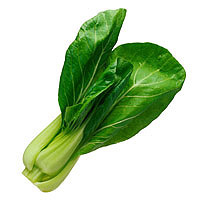Penn Herb Wellness Guide
Bok Choy

Preparation, Uses, & Tips
Chop off enough of the base of the bok choy plant before washing so that stalks can be cleaned individually. Rinse stalks and leaves under running water, using a vegetable brush if they are especially dirty at the base of the stalk.
Bok choy stalks can be consumed raw with dip, or chopped and used in salads. Bok choy has a high water content and becomes limp very quickly upon cooking. It should be cooked very quickly over high temperature so that the leaves become tender and the stalks stay crisp. In Chinese stir-fried dishes and soups, bok choy is added toward the end of the cooking process. Since the leaves cook much more quickly than the stalks, it’s a good idea to add the stalks first and then the leaves about a minute later. Cut the stalks into 1/2-inch (1.25cm) pieces before cooking.
To boil
Cook stems in salted water for four minutes and leaves for two to three minutes.
To steam
Allow pieces to steam for about six minutes, or until tender-crisp.
To saut
Stir-fry the stalks over high heat for about six minutes and the leaves for about three minutes, until stalks are tender-crisp and leaves are just wilted.
Bok choy goes well with the flavors of soy sauce, hot peppers, and toasted sesame oil.
Copyright 2025 TraceGains, Inc. All rights reserved.
Learn more about TraceGains, the company.
The information presented in the Food Guide is for informational purposes only and was created by a team of USregistered dietitians and food experts. Consult your doctor, practitioner, and/or pharmacist for any health problem and before using any supplements, making dietary changes, or before making any changes in prescribed medications. Information expires December 2025.


